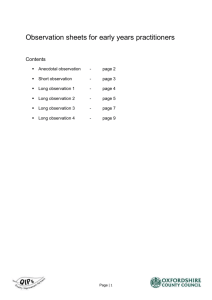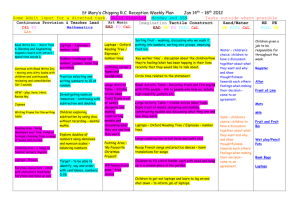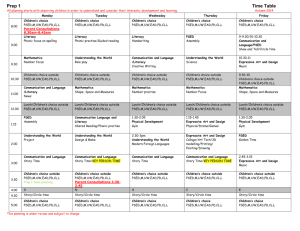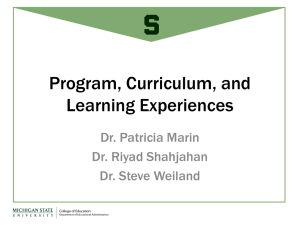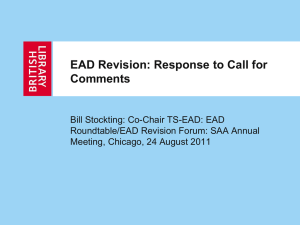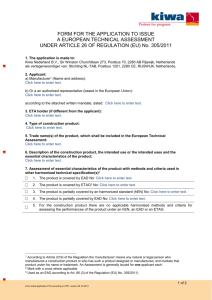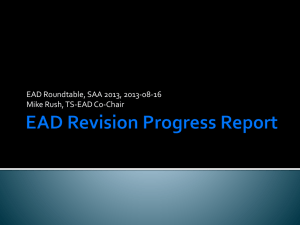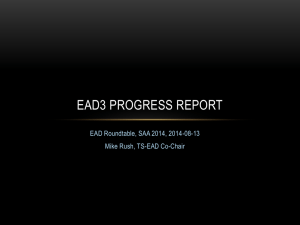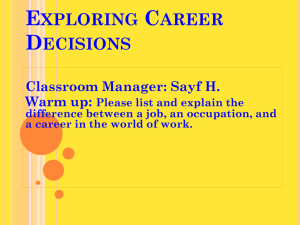Observation, Assessment and Planning templates (doc format, 236Kb)
advertisement
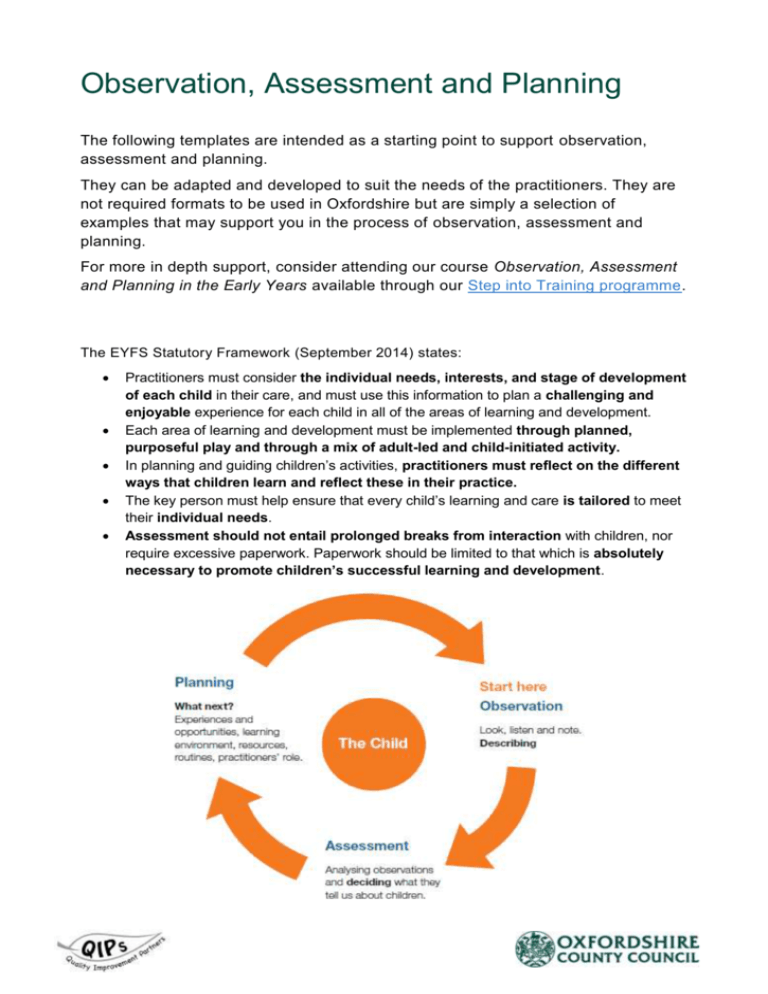
Observation, Assessment and Planning The following templates are intended as a starting point to support observation, assessment and planning. They can be adapted and developed to suit the needs of the practitioners. They are not required formats to be used in Oxfordshire but are simply a selection of examples that may support you in the process of observation, assessment and planning. For more in depth support, consider attending our course Observation, Assessment and Planning in the Early Years available through our Step into Training programme. The EYFS Statutory Framework (September 2014) states: Practitioners must consider the individual needs, interests, and stage of development of each child in their care, and must use this information to plan a challenging and enjoyable experience for each child in all of the areas of learning and development. Each area of learning and development must be implemented through planned, purposeful play and through a mix of adult-led and child-initiated activity. In planning and guiding children’s activities, practitioners must reflect on the different ways that children learn and reflect these in their practice. The key person must help ensure that every child’s learning and care is tailored to meet their individual needs. Assessment should not entail prolonged breaks from interaction with children, nor require excessive paperwork. Paperwork should be limited to that which is absolutely necessary to promote children’s successful learning and development. Contents Continuous provision planning ......................................................................................... 1 Focused activity plan ........................................................................................................ 3 Long observation timetable .............................................................................................. 4 Short observation template – look, listen, note ................................................................ 5 Weekly observation summary .......................................................................................... 6 Observation monitoring .................................................................................................... 7 Wow moment template .................................................................................................... 8 Narrative observation form ............................................................................................... 9 Short observation ........................................................................................................... 11 Long observation 1......................................................................................................... 12 Long observation 2......................................................................................................... 13 Long observation 3......................................................................................................... 15 Long observation 4......................................................................................................... 18 Characteristics of effective learning observation ............................................................ 20 Continuous provision planning Class ……….. Weekly Plan Date: Continuous/Enhanced Provision (INSIDE) Mon Tue Wed Thur Fri Writing Area Small World Malleable/ Tactile Area Role Play Mathematics Art Workshop Sand Water UW/Science/ Nature ICT Construction Key Green – Activities planned in response to children’s interests/next steps (with children’s initials) Blue – Activities to ensure a balance across the curriculum Page | 1 Continuous/Enhanced Provision (OUTSIDE) Mon Tue Wed Thur Fri PSED Communication And Language Physical Development Literacy Mathematics Understanding the World Expressive Arts and Design Sand Water Key Green – Activities planned in response to children’s interests/next steps (with children’s initials) Blue – Activities to ensure a balance across the curriculum Page | 2 Focused activity plan Date: Task: PSED Learning intention: PD CL L M UW EAD Key Vocab/Questions: Children Involved: Resources: Differentiation: Evaluation: Next steps: Page | 3 Long observation timetable Term: Autumn 1 Staff Member 1 Staff Member 2 Week 1 Lottie, Harry, Ben Josh, Molly, Gilbert Week 2 Lucy, Andy, Ahmed Sarah, Ellie Week 3 Marcus, Alfie, Martha Carl, James Week 4 Lily-Mae, Jess, Charlie Laura, Hannah Week 5 Tyrone, Esme, William Finlay, George Week 6 Ruby, Ollie Lottie, Dan Staff Member 3 N.B – This timetable is for a class of 30 children. A long observation would on average be between 5 – 10 mins. With three children to observe in this way over the week that is only a maximum of 30 mins per week. Page | 4 Short observation template – look, listen, note Look, Listen and Note Name…………………. Observed: PSED PD CL L Look, Listen and Note Date………… M UW Name…………………. Observed: EAD PSED PD Age band: Age band: Next step: Next steps: Look, Listen and Note Name…………………. Observed: PSED PD CL L UW Name…………………. Observed: EAD PSED PD Age band: Age band: Next step: Next steps: Look, Listen and Note Name…………………. Observed: PSED PD CL L UW M UW EAD CL Date………… L M UW EAD Look, Listen and Note Date………… M L Look, Listen and Note Date………… M CL Date………… Name…………………. Observed: EAD PSED PD Age band: Age band: Next step: Next steps: Page | 5 CL Date………… L M UW EAD Weekly observation summary Key Person: Week Beginning: Name Observation / Interest Links to EYFS 1 2 3 4 5 6 7 8 9 10 Page | 6 Possible Lines for Development Name Observation monitoring TERM: ___________________ PSED PD CL L Page | 7 M UW EAD Wow moment template Name _________________ Age ___________________ What I did_____________________________ _______________________________________________ _______________________________________________ _________________ Signed: ____________ Date: __________ Name _________________ Age ___________________ What I did_____________________________ _______________________________________________ _______________________________________________ _________________ Signed: ____________ Date: __________ Page | 8 Narrative observation form Name Date Context Time Observer Schemas observed in play Positioning Transporter Transformer Very precise about where things should be and enjoy lining up toys Carrying objects from one place to another in bags, buckets etc Mix colours, textures, enjoy malleable material Involvement scales 1.Extremely Low 2. Low No concentration, absent, passive attitude, no signs of exploring things Some degree of activity, limited concentration, fiddles, easily distracted 3. Moderate Busy all the time but no real concentration, activities are short lived, no dedication to an activity, not child’s full potential Rotation Connection Enclosure 4. High 5. Very High Fascinated by spinning wheels, wheels on cars, rotating items, enjoy spinning or being spun round Enjoy spending time joining things together, using tape to join or put together obstacle courses Fill empty containers, sit in tunnels, build dens or cages Engaged without interruption, real concentration most of the time, brief moments of distortion, child feels challenged and motivated Continuously engaged and absorbed, focussed without interruption, strongly appealed by activity. Is alert, shows precision, intense, engrossed in activity, child’s capabilities shine. Enveloping Covering up themselves or dolls/toys in blankets, painting using one colour Trajectory Play with running water, climb up and jump off equipment, throw toys and balls Playing and Exploring engagement Characteristics of effective learning Active Learning Creating and Thinking motivation Critically - thinking Finding out & exploring: Showing curiosity about objects, events and people Using senses to explore the world around them Engaging in open ended activity Showing particular interests Playing with what they know: Pretending objects are things from their experiences Representing their experiences in play Taking on a role in their play Acting out experiences with other people Being involved & concentrating: Maintaining focus on their activity for a period of time Showing high levels of energy and fascination Not easily distracted Paying attention to details Keeping trying: Persisting with activity when challenges occur Showing a belief that more effort or a different approach will pay off Bouncing back after difficulties Having their own ideas: Thinking of ideas Finding ways to solve problems Finding new ways to do things Being willing to “have a go”: Initiating activities Seeking challenge Showing a ‘can do’ attitude Taking a risk, engaging in new experiences, learning by trial and error Enjoying & achieving what they do: Showing satisfaction in meeting their own goals Being proud of how they accomplished something – not just the end result Enjoying meeting challenges for their own sake rather than external rewards or praise Choosing ways to do things: Planning, making decisions about how to approach a task, solve a problem and reach a goal Checking how well their activities are going Changing strategy as needed Reviewing how well the approach worked Page | 9 Making links: Making links and noticing patterns in their experiences Making predictions Testing their ideas Developing ideas of grouping, sequencing, cause and effect OBSERVATION NOTES:- NEXT STEPS PARENT INPUT Page | 10 Short observation Name of Child: Date: Areas of Learning Covered: PSED PD CL L Characteristics of Effective Learning Covered: Playing & exploring – engagement M UW EAD UW EAD Active learning – motivation Creating and thinking critically - thinking Context e.g. where taking place, child alone or in group, activity focus: Name of Observer: Observation Details: Next Steps: Name of Child: Date: Areas of Learning Covered: PSED PD CL L Characteristics of Effective Learning Covered: Playing & exploring – engagement M Active learning – motivation Creating and thinking critically - thinking Context e.g. where taking place, child alone or in group, activity focus: Name of Observer: Observation Details: Next Steps: Page | 11 Long observation 1 Long Observation 1 Name of child: Date: Activity: In/out Time: CI AI AD Areas of Learning and Development Prime areas PSED P Specific areas CL L M UW EAD Characteristics of Effective Learning PLAYING AND EXPLORING (engagement) ACTIVE LEARNING (motivation) CREATING AND THINKING CRITICALLY (thinking) Finding out and exploring Being involved and concentrating Having their own ideas Playing with what they know Keeping trying Making links Being willing to ‘have a go’ Enjoying achieving what they set out to do Choosing ways to do things NEXT STEPS FOR LEARNING? Page | 12 Long observation 2 Child: Observation: Characteristics of Effective Learning Playing and exploring – engagement Finding out & exploring Playing with what they know Being willing to ‘have a go Active learning – motivation Being involved and concentrating Keeping on trying Enjoying achieving what they set out to do Creating and thinking critically – thinking Having their own ideas Making links Choosing ways to do things Long Observation 2 Date: Time: Areas of Learning and Development Prime Areas Personal Social and Emotional Development Making relationships Self -confidence and selfawareness Managing feelings and behaviour Physical Development – Moving & handling Health & self-care Communication and Language Listening & attention Understanding Speaking Page | 13 Specific Areas Literacy Reading Writing Mathematics Numbers Shape, space and measure Understanding the World People & communities The world Technology Expressive Arts and Design Exploring and using media and materials Being imaginative Observation continued: Next Steps: Page | 14 Long observation 3 Long Observation 3 Name of child Date: Time: Observation completed by: Child Initiated Activity: Adult Led Activity: Solitary Play Small group Play Large Group Play PS C&L PD L M U the W EA&D ED Context: (where is the child? Who else is present?) What is happening? (What is the child saying and/or doing?) Page | 15 Is the child: Showing curiosity? Using their senses? Engaging in open ended activity? Showing particular interests? Maintaining focus on their activity for a period of time? Showing high levels of energy/fascination? Not easily distracted? Paying attention to detail? Pretending objects are things? Persisting with activity when challenges occur? Representing experiences in play? Showing belief that effort or a different approach will pay off? Taking on a role in play? Acting out experiences Bouncing back after Page | 16 Thinking of ideas? Finding ways to solve problems? Finding new ways to do things? Making links and noticing patterns in their experience? Making predictions? Testing their ideas? Developing ideas of grouping, sequencing, cause and effect? with other people? difficulties? Initiating activities? Seeking challenges? Showing satisfaction in meeting own goals? Showing a ‘can do’ attitude? Taking a risk? Engaging in new experiences and learning by trial and error? Proud of accomplishments regardless of end result? Enjoying meeting challenges for own sake? NEXT STEPS: Page | 17 Checking how well their activities are going? Changing strategy as needed? Reviewing how well the approach worked? Long observation 4 Long Observation 4 Child’s name: SEN Context (where, how) Age (in months): EAL Observer: Date: Time: Adult involvement: yes no OBSERVATION: What did you find out about the child’s learning across any of the 3 prime areas and 4 specific areas of learning? What was significant for the child? GENERAL PSED (MR; SC&SA; MF&B) PD (M&H; H&SC) CL(L&A; U; S) L (R; W) M (N; SSM) UW (P&C; TW; T) EAD (E&UM&M; BI) Page | 18 Characteristics of Effective Learning Playing and Exploring (Engagement) General (continued) Active Learning (Motivation) Creating and Thinking Critically (Thinking) Child’s Response (verbal and / or non-verbal (try to make time to inform the child about the observation. Consider showing the child a photograph of his / her play that was observed and capture his / her response). Significant progress and achievements identified during the observation. Page | 19 Learning priorities identified – What next? Characteristics of effective learning observation Name of child: Date: Time: Activity: Details / Context: (could include a photo) Playing and exploring Characteristics of effective learning (how children learn) shown in observation: Active learning Creating/thinking critically Finding out and exploring Showing curiosity about objects, events and people. Using senses to explore the world around them. Showing particular interests. Playing with what they know Pretending objects are things from their experience. Representing their experiences in play. Acting out experiences with other people. Being willing to have a go Initiating activities. Seeking challenge. Showing a “can do” attitude. Taking a risk, engaging in new experiences, and learning by trial and error. Being involved and concentrating Maintaining focus on their activity for extended periods of time. Showing high levels of energy, fascination. Not easily distracted. Paying attention to details Keeping on trying Persisting with activity when challenges occur. Showing a belief that more effort or a different approach will pay off. Bouncing back after difficulties. Enjoying achieving what they set out to do Showing satisfaction in meeting their goals. Being proud of how they accomplished somethingnot just the end result. Enjoying meeting challenges for their own sake rather than external rewards or praise. Have their own ideas Thinking of ideas. Finding ways to solve problems. Finding new ways to do things Making links Making links and noticing patterns in their experience. Making predictions. Testing their ideas. Developing ideas of grouping, sequences, cause and effect. Choosing ways to do things Planning, making decisions about how to approach a new task, solve a problem and reach a goal. Checking how well their activities are going. Changing strategy as needed. Reviewing how well the approach worked AREA OF LEARNING AND DEVELOPMENT: PSED AGE BAND: Birth – 11 months 8 – 20 months CL PD L 16 – 26 months M 22 – 36 months C B UW 30 – 50 months EAD 40 – 60+ months A Next steps: What will you do to celebrate/extend/provide opportunities to repeat or practice/change something/scaffold/consolidate? Page | 20
